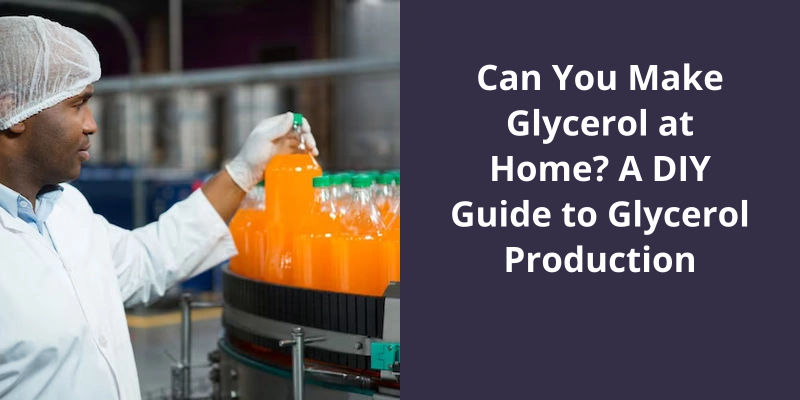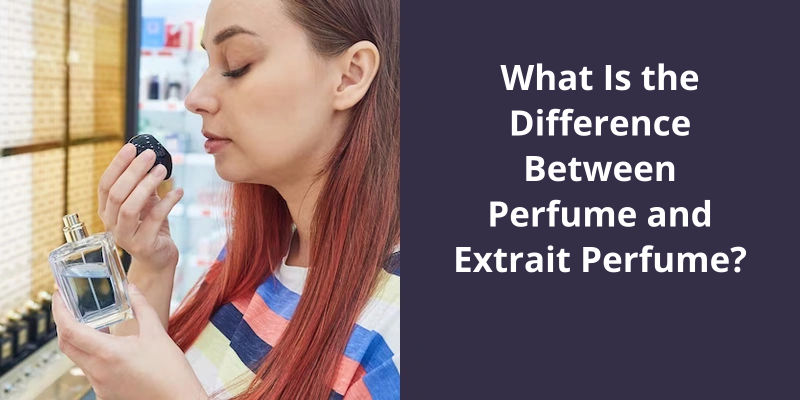Yes, it is possible to make glycerol at home though it’s quite complicated and requires careful handling of potentially dangerous chemicals. Glycerol, also called glycerin, often comes from soap making process, where it’s produced as a natural byproduct. To make it at home, you typically heat the fat or oil and then add a strong base like lye, causing a chemical reaction. This process, known as saponification, separates fatty acids from the glycerol. Once separated, the glycerol can be purified via distillation. However, this method involves using strong chemicals and dealing with the resultant high temperatures, which makes it hazardous unless handled properly. Therefore, it’s always safer to buy pre-made glycerol from reliable suppliers as opposed to making it yourself at home.

How Is Glycerol Made Naturally?
Glycerol, also known as glycerin or glycerine, is a colorless, odorless, and sweet-tasting liquid that’s commonly used in various industries, including pharmaceuticals, food, and cosmetics. It’s a triol compound made up of three hydroxyl groups, which gives it it’s unique properties and makes it useful in many different applications.
One of the most common ways of producing glycerol naturally is through the hydrolysis of fats and oils. This process involves breaking down the ester bonds that hold together the fatty acids in the oil, using an alkaline catalyst such as sodium hydroxide. The resulting mixture is then distilled to extract the glycerol, which is purified and refined before being used in various applications.
This method is commonly used in the production of biodiesel, where the glycerol byproduct is typically sold or used as a feedstock for other applications.
However, these methods are typically less economical and aren’t as commonly used as the natural routes.
As demand for glycerol continues to grow in various industries, it’s likely that new and innovative methods of production will continue to be developed and refined in the years to come.
The Various Applications and Uses of Glycerol, Including It’s Role in the Production of Personal Care Products, Food, and Medicine.
- Glycerol is commonly used in the production of personal care products such as soap, shampoo, and moisturizers.
- It’s a common ingredient in food processing, where it’s used as a sweetener, humectant, and preservative.
- Glycerol is used in medicine as a laxative, as well as in cough syrups and elixirs.
- It’s also used in the production of explosives, as a component of nitroglycerin.
- Glycerol can also be used as a solvent in a variety of industrial applications.
- It’s used in the manufacture of paper products, such as paper and cardboard, to prevent drying and cracking.
Aside from it’s uses in personal care products, glycerol also plays a significant role in other everyday applications. Whether you know it or not, this colorless, odorless, and sweet-tasting liquid has become a staple ingredient in most households, from the kitchen to the medicine cabinet. It’s versatility and unique properties make it an indispensable material in various industries, ranging from food and beverage, pharmaceuticals, and even explosives manufacturing. In this article, we will discuss some of the surprising benefits of glycerol in our daily lives.
What Is the Use of Glycerol in Everyday Life?
Additionally, glycerol is a common ingredient in the food industry. It’s used as a sweetener, humectant, and a preservative in many food products, including baked goods, candies, and dairy products. Glycerol can also be used as a solvent, providing a stable base for flavors and colors in food products. Furthermore, it’s often used as a sweetener substitute for individuals with diabetes, as it doesn’t raise blood sugar levels.
Another use for glycerol is in the production of various medications. Glycerol’s water retention properties make it useful in medical applications such as suppositories, where it helps the medication dissolve and be better absorbed by the body. It can also be used as a cryoprotectant, which helps protect living cells and tissues during the freezing process. Additionally, glycerol is sometimes used as an ingredient in cough syrups and expectorants, as it can help soothe irritation in the throat.
Moreover, glycerol has industrial applications. It’s a component in the production of certain explosives, such as nitroglycerin, and is also used in the manufacture of some plastics and resins. Glycerol is used as a lubricant in the textile industry, specifically in the processing of silk, wool, and other fibres. It’s also used in the production of various cleaning agents, including laundry detergents and soaps.
In veterinary medicine, glycerol is sometimes used as a treatment for ketosis in cows. Ketosis is a metabolic disorder that can affect dairy cows that are in early lactation or have experienced calving. Additionally, glycerol is sometimes used as a component in animal feed, as it can help preserve the moisture content of the feed and improve animal digestion.
It’s unique properties make it a valuable ingredient in many products and processes, and it’s likely to continue finding new uses in the years to come.
The Use of Glycerol in Cosmetic Products, Such as Moisturizers, Lotions, and Hair Care Products.
- Glycerol is a common ingredient in moisturizers and lotions.
- It’s also used in hair care products, such as shampoos and conditioners.
- Glycerol is a humectant, meaning it helps to retain moisture in the skin and hair.
- It’s often derived from natural sources, such as vegetable oil.
- Glycerol may also have some antimicrobial properties, making it useful in some cosmetic formulations.
- Overall, glycerol is a versatile and widely used ingredient in the cosmetic industry.
Understanding the natural sources of glycerol is important for a multitude of reasons, including it’s various uses in pharmaceuticals, food products, and cosmetics. While it can be commercially produced from fats and oils, there are also several fermented foods and beverages that naturally contain glycerin, making it a versatile ingredient. Let’s explore more about this fascinating substance and how it’s used.
What Is the Natural Source of Glycerol?
Glycerol, also known as glycerin, is a natural humectant and is used in a variety of industries, from food to personal care to pharmaceuticals. One of the primary natural sources of glycerol is through the fermentation of certain foods and beverages, including beer, honey, vinegar, wine, and wine vinegar.
In the production of beer and wine, yeast is added to the beverage during the fermentation process. During this process, the yeast breaks down the sugars in the beverage, creating alcohol as a byproduct. In addition to alcohol, the fermentation process also produces glycerol, which gives the beverage a slightly sweet taste and helps to enhance it’s mouthfeel.
Honey, which is a natural sweetener, also contains glycerol. When bees produce honey, they break down the sugars in flower nectar and convert them into fructose and glucose. During this process, glycerol is also produced as a byproduct, giving honey it’s unique flavor and texture.
Vinegar is made through the process of fermentation, in which bacteria break down the sugars in fruits or grains. During this process, glycerol is produced as a byproduct, along with acetic acid, which gives vinegar it’s tangy flavor.
In addition to these natural sources, glycerol can also be commercially produced from fats and oils, including vegetable oils, animal fats, and biodiesel. In this process, the fats and oils are heated to break down the fatty acids, which are then combined with an alkaline solution to form glycerol. This process is known as saponification, and the glycerol that’s produced is commonly used in personal care products, such as soaps and lotions.
It’s also commercially produced from fats and oils, and is used in a wide range of industries due to it’s unique properties as a humectant and texture enhancer.
The Health Benefits of Glycerol and It’s Use in Medicine.
Glycerol is a compound that’s various health benefits and is commonly used in medicine. It’s positive effects on skin, digestion, and hydration make it a valuable ingredient in many products. Additionally, glycerol has been used to treat various medical conditions like dehydration, constipation, and high blood pressure.
Now that we know what vegetable glycerin is and where it comes from, let’s take a closer look at it’s various applications. From skin care to food production, glycerin offers a versatile range of benefits that make it an essential ingredient in many different industries. Let’s explore some of it’s most popular uses and why it’s so highly valued by manufacturers and consumers alike.
What Ingredients Are Used to Make Glycerin?
The process of making glycerin involves heating a fat or oil with an alkali substance, such as soap or lye, to break it down into it’s component parts. The resulting mixture is then distilled to separate the glycerin from any other impurities or byproducts. In the case of vegetable glycerin, the raw materials used are usually sourced from organically grown crops to ensure the purity and quality of the final product.
One of the benefits of using vegetable glycerin is that it’s a natural and sustainable alternative to petroleum-based glycerin, which is often derived from non-renewable resources. Vegetable glycerin is also easier to work with in formulations, as it’s more stable and less prone to rancidity than animal-derived glycerin. Additionally, it’s a lower toxicity and environmental impact than other glycerin sources.
In the food industry, vegetable glycerin is commonly used as a sweetener or as a humectant, which helps to retain moisture in processed foods such as bakery items, cereals, and snacks. It can also be used as a thickening agent in sauces and condiments. In the medical field, glycerin is often used as a laxative or as a component of cough syrups and expectorants.
It’s known for it’s ability to attract and retain moisture, which helps to hydrate and plump the skin. Glycerin is also used in hair care products such as shampoos and conditioners, as it can help to reduce frizz and improve manageability.
It’s natural and sustainable properties make it an attractive choice for conscientious consumers, and it’s efficacy and safety have been well-established through decades of use. Whether youre looking to improve your skins hydration, sweeten your favorite baked goods, or relieve a stubborn cough, glycerin is a reliable and effective solution.
While glycerol has been found to have potential benefits for constipation, athletic performance, and certain skin conditions, it’s important to note that there are also many other uses for glycerol that lack scientific evidence to support their effectiveness. Additionally, the World Anti-Doping Agency has banned glycerol, which has led to further scrutiny of it’s potential uses in enhancing athletic performance.
What Are 3 Uses for Glycerol?
Glycerol, also known as glycerine, is a colorless, odorless, and slightly sweet-tasting liquid that’s commonly used in a variety of industries. It’s a polyol compound with three hydroxyl groups that make it highly soluble in water. One of the main uses of glycerol is as a laxative for treating constipation. When consumed, it attracts water into the intestine, making stool softer and easier to pass. Glycerol is also sometimes used to improve athletic performance, particularly in endurance sports. This is because it can help increase blood volume and delay fatigue by preventing dehydration during intense exercise.
Another use of glycerol is in skincare products. It’s often added to lotions, creams, and soaps to help moisturize and protect the skin. Because of it’s hygroscopic properties, it can help attract moisture to the skin and keep it from drying out. Some studies have even suggested that it may have anti-aging and antioxidant properties, although more research is needed to confirm these benefits.
Despite it’s potential benefits, glycerol is banned by the World Anti-Doping Agency (WADA). This is because it can be used to mask the presence of other prohibited substances in urine samples. Athletes who use glycerol may be able to dilute their urine and reduce the concentration of banned substances, making them more difficult to detect during drug testing. As a result, glycerol is classified as a masking agent and is therefore prohibited in sports competitions.
For example, it’s been studied for it’s potential to reduce brain damage after a stroke, although results have been mixed. It’s also been suggested as a potential treatment for obesity, as it can help reduce appetite and increase fat metabolism. However, more research is needed to determine it’s safety and effectiveness for these and other conditions.
Since it’s discovery in 1779 by the Swedish chemist Carl Wilhelm Scheele, glycerol has played a crucial role in numerous industries, including food and beverage, pharmaceuticals, and cosmetics. It’s prevalence in everyday products has made it a common ingredient in our daily lives, yet few understand it’s origins and how it was first discovered. Thanks to Scheele’s pioneering work, we now have a better understanding of how this versatile compound came to be.
Where Was Glycerol Found?
Though glycerol was not recognized explicitly until the late 1700s, it was present in many everyday substances consumed for centuries. This organic compound can be found naturally in plants and animals, and it’s considered one of the most versatile chemicals used in modern industries, including cosmetics, food, and pharmaceuticals. Beyond it’s applications in commerce, glycerol also plays a crucial role in the human body as a component of fats or lipids, providing insulation and energy storage.
The Swedish chemist Carl Wilhelm Scheele was known for his pioneering research in organic chemistry. He discovered several important compounds, including glycerol, and his works have contributed significantly to the development of modern medicine and sciences. Scheeles discovery of glycerol opened up a new field of study as chemists began to investigate the compounds properties and possible uses. Today, glycerol is widely used as a solvent, plasticizer, and humectant.
Glycerol is commonly found in many household items, from moisturizers to processed foods. It’s also a significant byproduct in the production of biodiesel – a renewable source of energy distilled from vegetable oils. Glycerol is used in the biodiesel production process as a catalyst, and it’s recovery and purification are essential to achieving a high-quality biofuel. The growing demand for sustainable, environmentally friendly energy has led to a surge in glycerol production, which has created new avenues for research and innovation.
Despite it’s wide usage and contribution to various industries, glycerol remains a relatively unknown compound to many people.
Conclusion
This process offers an alternative to purchasing glycerol from stores or making it from other expensive sources such as vegetable oils. It’s also an excellent way to utilize leftover waste products, reduce waste, and even save money in the process.





